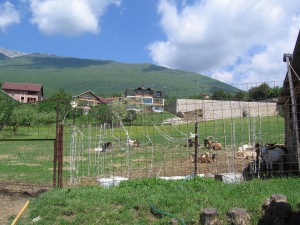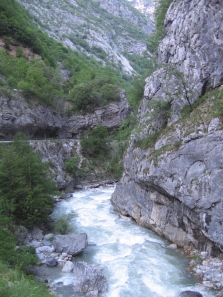“Kosovo? You are going to Kosovo? Is that safe? What about the border crossing—where will you enter?” my friends in Croatia asked me. Even in this part of the world, there is a myriad of unknown surrounding Kosovo, and many people I talked to had never visited it themselves.
Although the war in Kosovo—parties involved being Serbian forces, NATO, and the Kosovo Liberation Army(KLA)—has been over for 14 years, certain areas are still tense as the international community attempts to mediate disparate claims between Serbia and the five-year old Kosovo. Kosovar Serbs, who still do not recognize Kosovo’s government, are outraged at the recent Brussels agreement which attempts to move them towards a workable integration, even while allowing them some measure of autonomy. 
All of this was on my mind as my friend and I left the groomed highway of central Serbia and bounced along the poor, deeply rutted roads of Southern Serbia.
After some research and worry, we had no problems at the border. The Serbian guard joked with us as he glanced at our passports, and the Kosovo side charged us 30 Euros for insurance—which, as it turns out, was not a bad investment as I quickly realized that driving in Kosovo felt like an “every man for himself” adventure.
Although it was rapidly growing dark, the “urban” landscape difference between Southern Serbia and Kosovo was almost immediately noticeable—it was apparent from the buildings and houses that a lot of money had been poured into Kosovo since the war, in contrast to the rural poverty of Southern Serbia.
We drove a couple of more hours to our first destination—Pejě/Peć. Largely  destroyed by the war, it is now completely rebuilt and bordered by startlingly high green mountains. I was astonished when we passed the monastery—considered the “spiritual seat” of Patriarchs for the Serbian Orthodox Church, it is surrounded by barbed wires and guarded by KFOR(NATO-led international peacekeepers). There are still a couple dozen nuns inside, but we were informed by the polite Slovenian guard that we had missed visiting hours.
destroyed by the war, it is now completely rebuilt and bordered by startlingly high green mountains. I was astonished when we passed the monastery—considered the “spiritual seat” of Patriarchs for the Serbian Orthodox Church, it is surrounded by barbed wires and guarded by KFOR(NATO-led international peacekeepers). There are still a couple dozen nuns inside, but we were informed by the polite Slovenian guard that we had missed visiting hours.
The history and present situation of Kosovo is difficult to wrap my mind around,  and in some ways the “double-named” towns shown on the map (Pejě is Albanian and Peć is Serbian) illustrate what I discovered—viewpoints on the past and current situation radically differ depending on whether the person is Kosovar Albanian or Kosovar Serb, whether the person is Muslim, Orthodox, or Protestant. Of course, I don’t mean to imply that truth does not exist or that a correct understanding is not critically important—but an outsider must tread carefully, examining each strand of influence, information, and nuance before drawing any conclusions.
and in some ways the “double-named” towns shown on the map (Pejě is Albanian and Peć is Serbian) illustrate what I discovered—viewpoints on the past and current situation radically differ depending on whether the person is Kosovar Albanian or Kosovar Serb, whether the person is Muslim, Orthodox, or Protestant. Of course, I don’t mean to imply that truth does not exist or that a correct understanding is not critically important—but an outsider must tread carefully, examining each strand of influence, information, and nuance before drawing any conclusions.
The stories I gained on my journey were fascinating and tragic—from Kosovar Albanians who had lost family members in the slaughter of a village, to a Serbian Baptist who bravely stayed for his flock until finally fleeing for his life from his childhood town, to the complex religious-political situation that the Protestant churches now face. As always, I found God alive and well and actively working in Kosovo. Please join me for the next few blogs where I muse over some of my findings and stories.
For more information on the recent EU-brokered deal: Kosovo, Serbia agree EU deal action plan


Serbs are Orthodox not Protestant.
Karl Haudbourg
Serbia’s Ambassador to the World
http://www.ambassador-serbia.com/
Yes, thank you Karl. I know that, but I was actually referring to the small Protestant community in Kosovo in that sentence, not the Serbian Orthodox. I will nuance that sentence so as to not cause others confusion.
Thank-you for showing me places that I may never get to visit, and for introducing me to cultures I am so ignorant of.